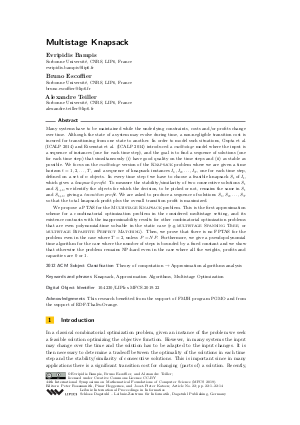@InProceedings{bampis_et_al:LIPIcs.MFCS.2019.22,
author = {Bampis, Evripidis and Escoffier, Bruno and Teiller, Alexandre},
title = {{Multistage Knapsack}},
booktitle = {44th International Symposium on Mathematical Foundations of Computer Science (MFCS 2019)},
pages = {22:1--22:14},
series = {Leibniz International Proceedings in Informatics (LIPIcs)},
ISBN = {978-3-95977-117-7},
ISSN = {1868-8969},
year = {2019},
volume = {138},
editor = {Rossmanith, Peter and Heggernes, Pinar and Katoen, Joost-Pieter},
publisher = {Schloss Dagstuhl -- Leibniz-Zentrum f{\"u}r Informatik},
address = {Dagstuhl, Germany},
URL = {https://drops.dagstuhl.de/entities/document/10.4230/LIPIcs.MFCS.2019.22},
URN = {urn:nbn:de:0030-drops-109664},
doi = {10.4230/LIPIcs.MFCS.2019.22},
annote = {Keywords: Knapsack, Approximation Algorithms, Multistage Optimization}
}

 Creative Commons Attribution 3.0 Unported license
Creative Commons Attribution 3.0 Unported license











